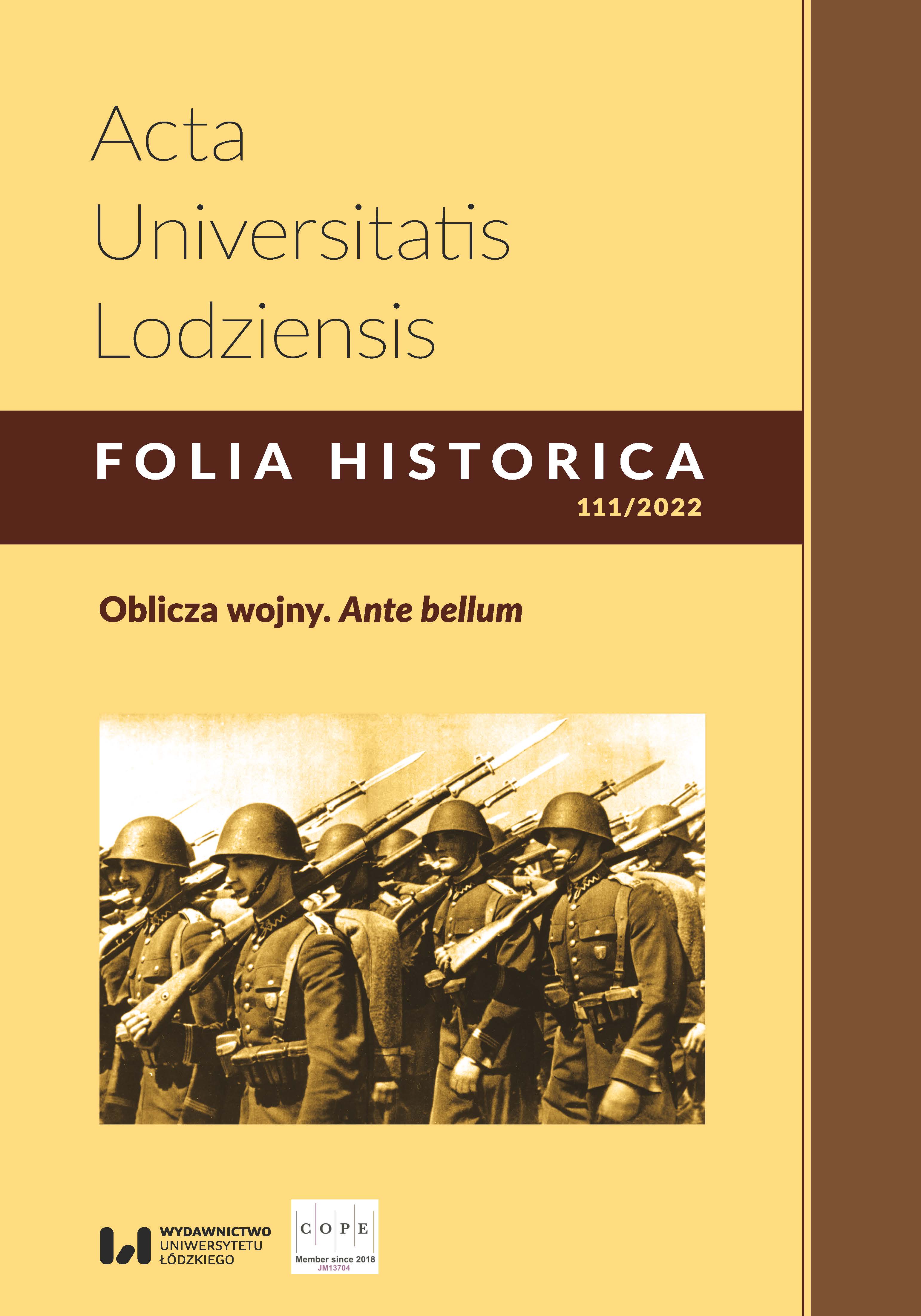Wybrane instrukcje archiwalno-kronikarskie tzw. Armii Andersa
DOI:
https://doi.org/10.18778/0208-6050.111.15Słowa kluczowe:
instrukcje archiwalne, Polskie Siły Zbrojne w ZSRR, Wojsko Polskie na Środkowym Wschodzie, Armia Polska na Wschodzie, 2 Korpus Polski, Władysław AndersAbstrakt
W pierwszych latach II wojny światowej tysiące Polaków deportowano do Związku Socjalistycznych Republik Radzieckich (dalej: ZSRR), wolność odzyskali dopiero w drugiej połowie 1941 r. Wielu z nich wstąpiło do Polskich Sił Zbrojnych w ZSRR dowodzonych przez gen. Władysława Andersa, z którego oddziałami przeszli szlak bojowy. Wraz z procesem tworzenia oraz rozwoju armii, powstawały komórki archiwalne, których zadaniem było m.in. kształtowanie wojskowego zasobu archiwalnego, wydawanie instrukcji archiwalnych oraz zlecenia prac kronikarskich w oddziałach.
Jednym z pierwszych takich dokumentów było pismo Szefa Sztabu Dowództwa Polskich Sił Zbrojnych z 16 grudnia 1941 r., regulujące zasady prowadzenia prac kronikarskich w oddziałach oraz sposoby przeprowadzania ankiet walk we wrześniu 1939 r. Dwa tygodnie później (30 grudnia 1941 r.) w 5 Dywizji Piechoty wydano rozkaz wykonawczy wraz z instrukcjami dla kronikarzy dywizyjnych, pułkowych i batalionowych. Kolejny ważny dokument to pismo gen. Andersa z 20 lutego 1943 r. dotyczące organizacji pracy kronikarsko-historycznej i archiwalnej Armii Polskiej na Wschodzie, regulujące istnienie służby archiwalnej oraz prowadzonych przez nią prac. Instrukcja ta wprowadzała także obowiązek uzupełniania dzienników przez jednostki biorące udział w działaniach wojennych.
Wprowadzone w lutym 1943 r. zasady prowadzenia dzienników działań zostały zmienione 20 marca 1945 r. w związku z ich nieprzestrzeganiem, kiedy to Dowództwo 2 Korpusu Polskiego wydało nową instrukcję prowadzenia dzienników działań. W celu zabezpieczenia dokumentów oraz uregulowania ich przekazywania z kancelarii do archiwum, Dowództwo Jednostek Wojska na Środkowym Wschodzie wydało 6 kwietnia 1945 r. rozkaz o gromadzeniu i przechowywaniu akt i pamiątek wojskowych.
Pobrania
Bibliografia
Archiwum Instytutu Polskiego i Muzeum im. gen. Sikorskiego w Londynie [AIPMS], 5 Dywizja Piechoty. Kryptonim „B”, sygn. A.VII.2/18
Google Scholar
Archiwum Instytutu Polskiego i Muzeum im. gen. Sikorskiego w Londynie [AIPMS], Akta 5 Kresowej Dywizji Piechoty (zbiór gen. Sulika), sygn. A.XI.70/56
Google Scholar
Archiwum Instytutu Polskiego i Muzeum im. gen. Sikorskiego w Londynie [AIPMS], Dowództwo 3. Korpusu, sygn. A.VIII.5/20
Google Scholar
Archiwum Instytutu Polskiego i Muzeum im. gen. Sikorskiego w Londynie [AIPMS], Kronika Samodzielnego Referatu Archiwalnego, sygn. C.137
Google Scholar
Archiwum Instytutu Polskiego i Muzeum im. gen. Sikorskiego w Londynie [AIPMS], Samodzielny Referat Historyczny [Armia Polska na Wschodzie], sygn. A.VIII.42/2
Google Scholar
Archiwum Instytutu Polskiego i Muzeum im. gen. Sikorskiego w Londynie [AIPMS], Samodzielny Referat Historyczny [2 Korpus], sygn. A.XI.57/10
Google Scholar
Anders W., Bez ostatniego rozdziału. Wspomnienia z lat 1939–1946, Warszawa 2007.
Google Scholar
Janczak B., Armia Polska na Wschodzie (1942–1943). Powstanie, organizacja, wyszkolenie, [w:] Studia z dziejów Polskich Sił Zbrojnych na Zachodzie (1939–1947), red. P. Chmielowiec, K. A. Tochman, Rzeszów 2018, s. 117–131.
Google Scholar
Kierepka K., Służba archiwalna Armii Polskiej we Francji w latach II wojny światowej, [praca magisterska napisana pod kierunkiem prof. dr. hab. K. Stryjkowskiego, Wydział Historii Uniwersytetu im. Adama Mickiewicza w Poznaniu], Poznań 2020.
Google Scholar
DOI: https://doi.org/10.4467/2391-890XPAH.21.007.15312
Oppman E., Historia powstania Instytutu Historycznego im. gen. Sikorskiego, jego cele i zadania, [w:] Instytut Historyczny im. generała Sikorskiego, Londyn 1957, s. 5–11.
Google Scholar
Polskie Siły Zbrojne w drugiej wojnie światowej, t. II (Kampania na Obczyźnie), cz. 2, Londyn 1975.
Google Scholar
Roman W. K., Archiwa Polskich Sił Zbrojnych na Zachodzie, „Archiwa – Kancelarie –Zbiory” 2016, nr 7(9), s. 49–75.
Google Scholar
DOI: https://doi.org/10.12775/AKZ.2016.003
Roman W. K., Centralne Archiwum Wojskowe 1918–1998. Tradycje, historia, współczesność służby archiwalnej Wojska Polskiego, Toruń 2009.
Google Scholar
Roman W. K., Polskie akta wojskowe w czasie wojny, „Piotrkowskie Zeszyty Historyczne” 2001, nr 3, s. 223–253.
Google Scholar
Suchcitz A., Powstanie Instytutu Historycznego im. Gen. Sikorskiego, [w:] Idea Europy i Polska w XIX–XX w. Księga ofiarowana dr. Adolfowi Juzwience, dyrektorowi Zakładu Narodowego im. Ossolińskich, z okazji 60-lecia urodzin, red. J. Degler et al., Wrocław 1999, s. 184–196.
Google Scholar
Tym J. S., Dzieje wojska Polskich Sił Zbrojnych na Zachodzie w historiografii ostatnich trzech dekad, „Klio. Czasopismo poświęcone dziejom Polski i powszechnym” 2019, t. XLIX, nr 2, s. 107–127.
Google Scholar
DOI: https://doi.org/10.12775//KLIO.2019.016
Tym J. S., Dzieje wojska Polskich Sił Zbrojnych w latach 1940–1947. Stan badań i perspektywy rozwoju (część 2), „Przegląd Historyczno-Wojskowy” 2020, t. XXI, nr 2(272), s. 42–77.
Google Scholar
DOI: https://doi.org/10.32089/WBH.PHW.2020.2(272).0002
Wawer Z., 5 Dywizja Piechoty w ZSRR 1941–1942, [w:] 5 Kresowa Dywizja Piechoty 1941–1947. Zarys dziejów, red. A. Suchcitz, Londyn 2012, s. 1–61.
Google Scholar
Wawer Z., Armia generała Władysława Andersa w ZSRR 1941–1942, Warszawa 2012.
Google Scholar
Pobrania
Opublikowane
Jak cytować
Numer
Dział
Licencja

Utwór dostępny jest na licencji Creative Commons Uznanie autorstwa – Użycie niekomercyjne – Bez utworów zależnych 4.0 Międzynarodowe.











